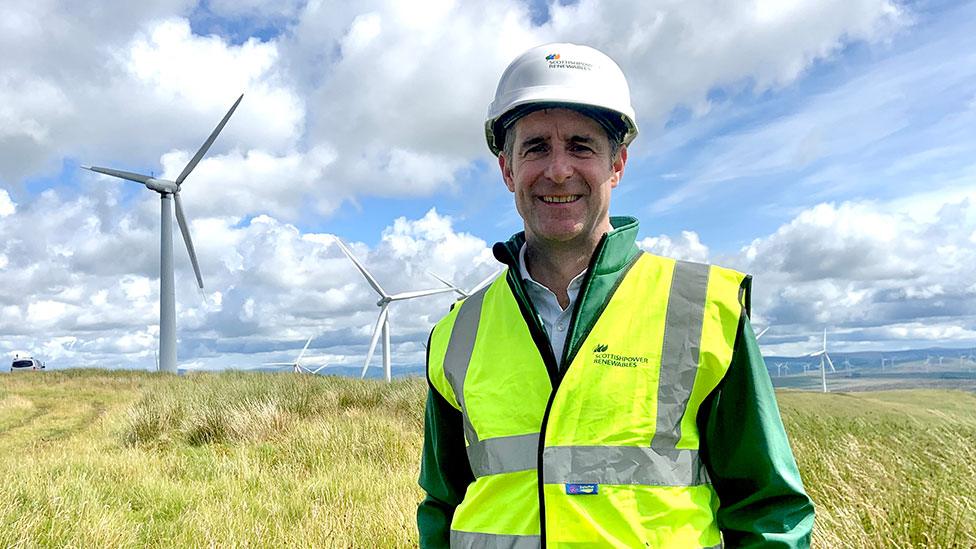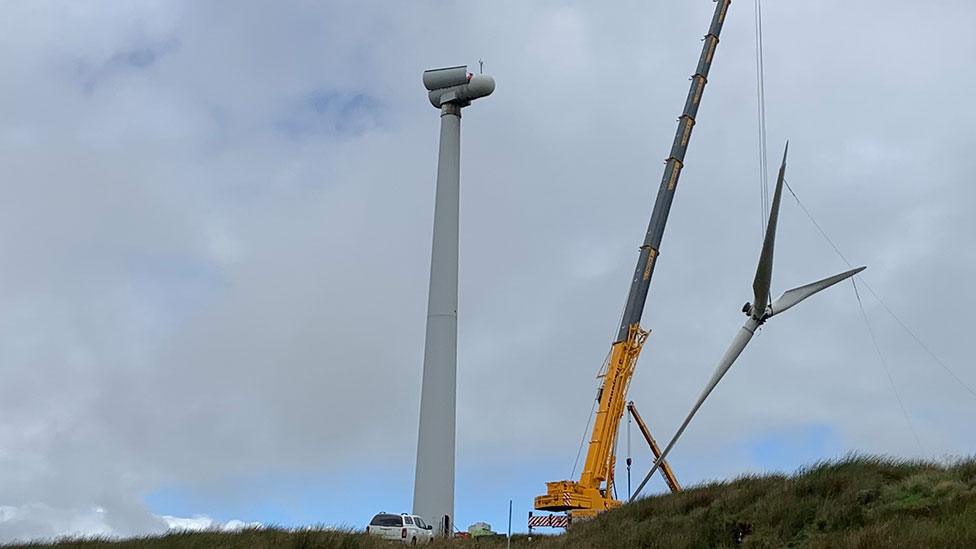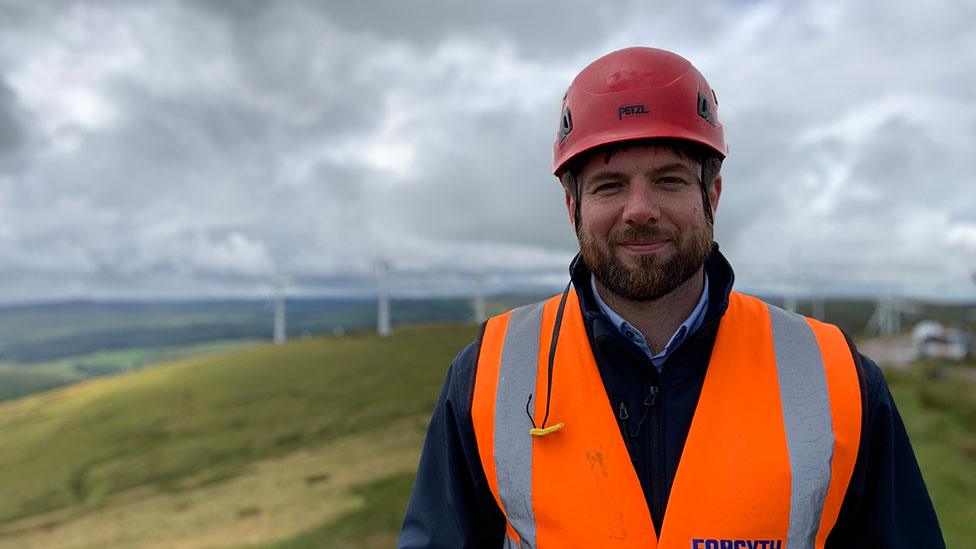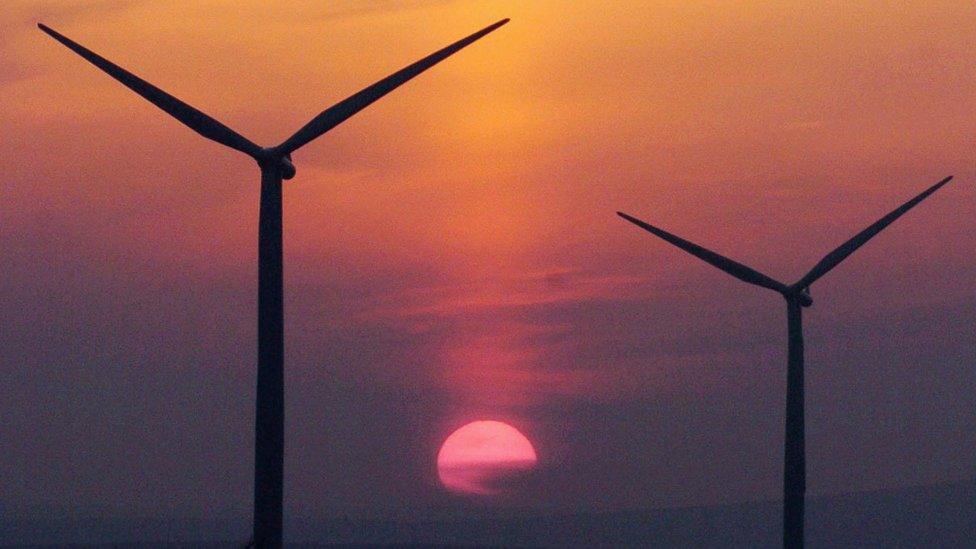Hagshaw Hill: Turbines dismantled at Scotland's oldest wind farm
- Published

Hagshaw Hill wind farm in South Lanarkshire was Scotland's first commercial wind farm
Wind energy has entered a new era on a hill in South Lanarkshire, as the first generation of turbines are dismantled.
Twenty-eight years after starting to produce power as Scotland's first commercial windfarm, Hagshaw Hill has been approved for "re-powering".
Its owner, Scottish Power Renewables, plans to build fewer, larger turbines.
Where those coming down have their nascelle, or generating unit, 35m (114ft) above the ground, the new ones could be as high as 140m (460ft).
And with improvements in blade design and the efficiency of turbines, each installation will be able to harness as much as 10 times more power from the wind than the ones they are replacing, with a capacity rating of six megawatts.
Scottish Power Renewables says the 14 larger turbines they want to install on the site near the village of Douglas will produce five times as much power as the 26 old turbines they are replacing.
However, there are industry concerns that re-powering will be delayed and made much more costly by lengthy planning processes.
The application to repower Hagshaw Hill wind farm was first made in December 2018. It was approved in February 2020.

Charlie Jordan wants to see planning permission for repowering wind farms fast-tracked
Replacement turbines require entirely new planning permission. But Charlie Jordan, chief executive of Scottish Power Renewables, says they could be fast-tracked because there is so much information already available about the sites.
"We've been operating this site for the best part of 30 years," he said. "We know everything about the site from an environmental perspective and we need to take the information and use it to accelerate planning of repowering projects."
New planning guidelines, external, published this year by the Scottish government, say that future planning approvals for wind farms should be "in perpetuity".
However, the requirement for new permission is being seen as an opportunity to ensure local communities secure more financial benefit from the profits now being made by wind farm operators.
When first installed, they required large subsidies, but the cost and efficiency of the technology has plummeted so that they can now be installed onshore on a commercially-viable basis.
The current stage of the process at Hagshaw Hill, which began earlier this month, is the dismantling of the turbines. On Wednesday, the seventh of 26 turbines was being removed, as the sixth was taken away by trucks.

Wind farms are currently being dismantled on Hagshaw Hill
Ryan Walker, project manager for crane and transport specialist Forsyth of Denny, says it is not about demolition but reversing the process of construction.
Whereas larger turbines will require each blade to be separately removed, all three of them can be lifted at once on these smaller and older ones.
Weather permitting atop the 500m hill, a team of 11 contractors with three cranes are lifting the turbines, the nascelles and the steel towers at a rate of one per day, ahead of the concrete foundations being removed.
Re-powering will gather pace across Scotland as other turbines reach the end of an expected working life of 25 years, extending for some of them up to 30 years.

Ryan Walker is part of the team dismantling the old wind turbines
They suffer from wear and tear in components and weather damage to the blades, as well as being much less efficient than the turbines that will replace them.
There are more than 11,000 wind turbines installed in Britain, with many more planned for offshore. And while most of a turbine can be recycled, including the steel towers and components in the gearing and generator, more than 33,000 blades present a challenge.
Many replaced blades have so far been sent to landfill. In some cases, they can be incinerated. But as replacement begins, the industry is looking for ways to re-purpose or re-cycle them instead.
ReBlade is one company, based in Glasgow and Dumfriesshire, with plans to build a re-purposing factory. Run by Fiona and Steven Lindsay, former Scottish Power employees, its demonstration projects include park benches and furniture.

Fiona Lindsay wants to find more ways to reuse or recycle wind turbine blades
It is announcing today a contract with SSE to use former blades as shelters in Dundee for electric vehicle charging points.
The skills involved in cutting extremely durable composite glass fibre are not available in Scotland, so it has gone to a boat-building firm near Colchester.
Fiona Lindsay says wind farm operators want to find ways to avoid sending blades to landfill, and will pay to have them re-purposed.
A longer-term financial basis is yet to be negotiated, but ReBlade hopes to employ hundreds of people by the end of the decade in re-using materials, with plans to open a re-manufacturing facility in the Dumfries area.
Energy minister Gillian Martin said: "We support in principle the 'repowering' of existing wind farm sites. Bold action is required to tackle the climate emergency and our processes aim to ensure applications for development are dealt with quickly.
"Decisions on wind farms at Hagshaw Hill in South Lanarkshire and Tangy IV on the Kintyre Penninsula were made within 15 months, a year ahead of average.
"We expect communities to benefit from the deployment of onshore renewables and have set out how developers and neighbourhoods can work together to ensure maximum engagement and benefit from renewable energy developments."
- Published2 October 2021

- Published13 May 2020
